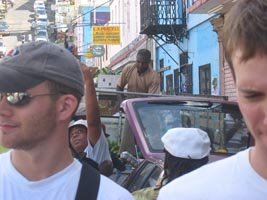First term classes
Your first term classes:
ANATOMY
You are given a binder that contains, in order, every lecture for the term. This is useful for both following lecture and adding your own notes in the margin. You are given an Anatomy Atlas by Netter that contains oil paintings of every structure in the body with labels. You also receive Essential Clinical Anatomy by Moore which is the closest thing you will have to a text book. How helpful people found these texts is based more on individual learning styles than the actual content of the book. There are two books which nearly everyone found helpful that the campus bookstore does not always carry:
The Color Atlas of Anatomy by Rohen (ISBN# 0683304925)
An invaluable companion to the lab portion of your class, this book contains pictures of perfectly dissected cadavers to help in your ability to identify structures both in lab and on exams. This is best used in conjunction with your Netter Atlas.
Gross Anatomy by Chung (ISBN# 0683307274)
Part of the Board Review Series (BRS) collection, this book covers the material stressed on the USMLE Step 1, offers tables and clinical explanations that can save you hours in the library, and has hundreds of clinical questions that help you to prepare for your exams.
BIOCHEMISTRY
To date, the biochemistry department gives lecture handouts to the class two to three days before each specific lecture. These handouts reflect the stress and focus that each professor will give to the material. To fill in any gaps and round out your understanding, two textbooks are given. Lipincott’s Illustrated Biochemistry is an excellent textbook that closely follows the scope of the class. The other text, Mark’s Basic Medical Biochemistry, aims to tie everything that you will earn into clinical vignettes with patients like Al Martini the alcoholic.
You will kick yourself if you do not also purchase the Biochemistry BRS book (ISBN# 0683304917). It is written by, get this, Dr. Mark’s wife: Dr. Mark. She goes through her husband’s text, pulls the pertinent illustrations, and puts all of the information into a bare-bones linear style that makes learning the material laughably simple. Because of this, you could make the case that you do not need the full Marks text if you are going to buy the BRS book. Once again, the school bookstore does not always carry this title, so I suggest bringing it to the island.
HISTOLOGY
The Histology faculty has the best companion of all of your classes. It is so comprehensive as to be considered its own textbook. You will also have access to a free program called HistoTime. HistoTime consists of short histology lessons followed by hundreds of slides to help you recognize each specific tissue type. This program along with the companion is all that you need to do well in the course and walk away with an understanding of histology. That said, some students found the two textbooks required for the class (Color Atlas of Histology by Gartner and Basic Histology by Junqueira) to be helpful.
EMBRYOLOGY
The embryology course is changing faculty so I cannot guarantee that anything I am about to type is accurate. Embryology operates from a single textbook and a course companion. Some students complain that the course companion is hard to follow and is poorly written. While this is not altogether untrue, it is more accurate to say that Embryology is a difficult course of study in the first place and there are few things that could make it easy to follow and understand. One text that does a fair job of making the course manageable is the Embryology BRS book (ISBN #0683302728). Once again, the school bookstore may not carry this title, and I would suggest bringing it with you to the island.



0 Comments:
Post a Comment
<< Home